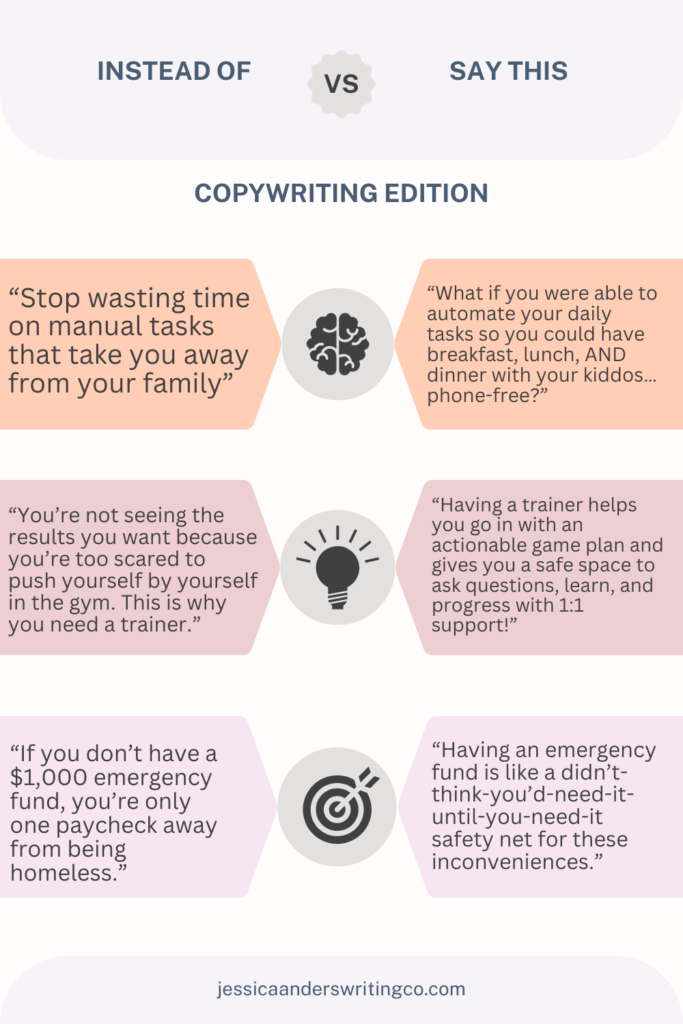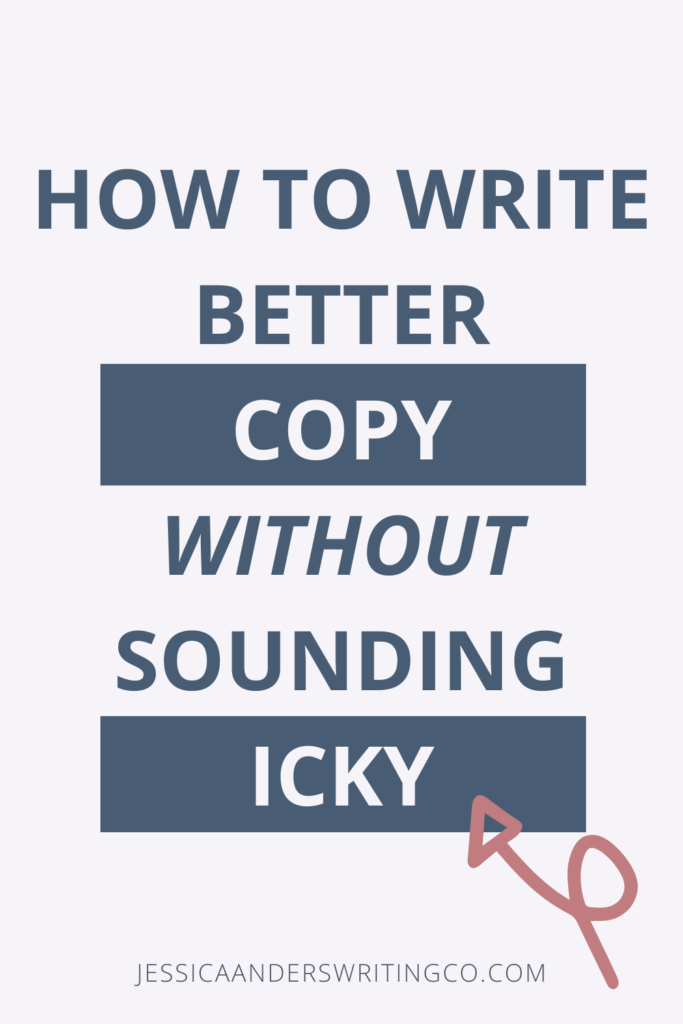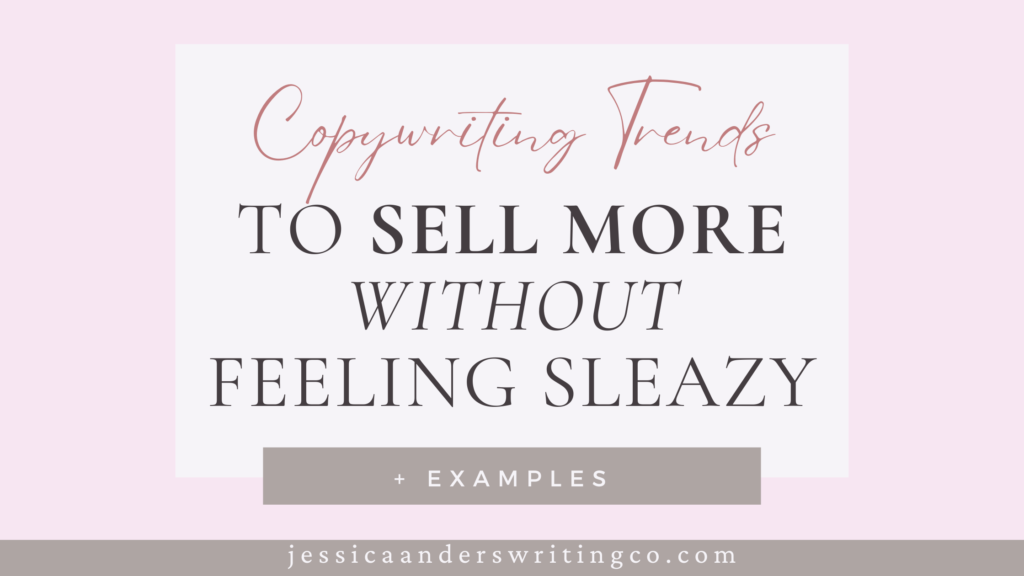-> In this article, we are analyzing the latest trends in copywriting for 2024/2025. Some trends are here to stay and others HAVE GOT TO GO!!! Let’s talk about it.
Even if I’ve said it a million and two times, over and overrr and overrrrrrr…
I’m willing to say it again, hopefully in a new(ish) way, for your gain.
Today, we’re talking about what I predict to be the 2024 – 2025 (at the least) copywriting trends: what’s out, what’s in, and how to stay ready so you don’t have to get ready.
TLDR; I believe you are the best-fit copywriter for your business because you know it + your offers better than anyone! If you want to learn how to write copy that converts better than a copywriter, you need to check out this program (click here).
Copywriting Trends That Are So Last Decade
Okay, okay, these are probably practices you saw like…last year…but they’ve been taught for AGESSSSS.
We’re just now getting to move through and past them (THANK GOD, TRULY!!)!
As we go through these, I’ll show you some examples of what this could look like AND how you can change your copy if you find yourself falling into these habits.
(Uh, yeah. You’re welcome.)
1. Pain Point Provoking
We’re getting R I G H T into it, lmao.
I’m so sick of seeing businesses do their very freaking best to make consumers feel like hot garbage, and then staking their offer/product/service as the only solution to get them out of pain.
No, no, no.
If you didn’t create an offer that makes your community/clients feel like shit, don’t write copy that does.
Okay? Okay.
It truly is that simple.
“But Jess, how do I write a sales page without pain points? Jim and John said I had to include 3 pain points right away and then elaborate on them for the duration of my 13-page-long sales letter.”

How to Market Without Using Pain Points:
- “Stop wasting time on manual tasks that take you away from your family”
“What if you were able to automate your daily tasks so you could have breakfast, lunch, AND dinner with your kiddos…phone-free?”
(In this example, instead of harping on the pain points that time is being wasted and family isn’t prioritized, we paint a positive dream world that moves them where they want to go, without making them feel like shit about where they are.)
- “You’re not seeing the results you want because you’re too scared to push yourself by yourself in the gym. This is why you need a trainer.”
“The gym is a super fkn intimidating place, especially as a beginner! Having a trainer helps you go in with an actionable game plan and gives you a safe space to ask questions, learn, and progress with 1:1 support! You aren’t going at this alone.”
(In this example, instead of harping on the pain points that they aren’t seeing results and feel scared or in need of something, we SHOW them HOW having a trainer can help them see more results and support them with things bigger than just results. Plus, we SEE them by validating intimidation.)
- “If you don’t have a $1,000 emergency fund, you’re only one paycheck away from being homeless.”
“Life happens at the most inconvenient times – don’t we all know it!! Lol. Having an emergency fund is like a didn’t-think-you’d-need-it-until-you-need-it safety net for these inconveniences. In this program, I help you save your first $1k regardless of your income and without counting pennies, cutting out your weekly thrift run, or becoming a s3x worker (unless that’s you’re thing. In that case, eat it up, baby!!!)
(Firstly, wtf? Lol. I hate that I could even come up with so easily because I’ve heard similar variations so freakinggggg much!!! And also, SIGN ME UP FOR THIS PROGRAM!!! Anyways. In this example, instead of harping on the pain points of not having cash saved, losing a career, or becoming homeless, we make them feel right at home with our tone and word choice. There’s no shame, instead we show them what could make them feel just a smidge safer! Andddd, we try to make them laugh. Bc I’m funny, and money is a heavy topic.)

See, removing pain points from your marketing doesn’t mean you aren’t helping them move away from what they don’t want!
But instead of focusing on everything they’re doing wrong, we show them what life could look like if they tweaked a few things.
We call them into THEIR power.
Plus, we use words they’d use. (We’ll get into these a bit later.)
2. Price Anchoring & Value Vs Pricing
Hahaaaa, because I used to think this was such a science and now I just can’t even.
Price anchoring is when you compare the price of your offer to things your ideal client is already investing in.
(Think daily coffee runs, software/programs/trainings, monthly recurring payments, similar products…)
Value vs pricing is when you have a million bonuses and curriculum, all valued at collectively $1,000,000,000 when your offer price is $100. Like…wut?
Now, I don’t think price anchoring is inherently bad/wrong…
But I do think it’s not as popular, beneficial, or highly converting anymore.
Why?
- We’re so used to being fed lies, these numbers look so silly.
- “This is less than your daily $20 run to Starbucks” – We don’t spend $20 on coffee every day. No. (Don’t lie.)
- “This course is valued at over a billion dollars and you’re getting it for $49.99!” What used to be like WOW OMG YES THANK YOU is now a ummm so like 99% of this course isn’t even valuable. No thank you.
- You’re basing your numbers on…nothing.
- You can’t ground in or anchor pricing that isn’t directly anchored or compared to something else. So your one-of-a-kind, unique offer can’t be compared to a $9 coffee run or $1,000/mo coaching. Using these methods is hurting you, not helping you.
So, what can you do instead of price anchoring or value vs pricing? 
Well, make the true value so dang good and clear, your community doesn’t think, “Hmm, what can I cut out of my life to get this,” and instead thinks, “No, I gotta have it. I’ll figure out the rest, but this is for me, FOR SURE!”
Also known as – create a great product, outstanding service, or no-brainer offer.
Then, and only then, sell it.
3. Hidden Pricing
I’ve never understood why this was a practice.
I mean, I guess from a psychology standpoint, I do get it.
But from a “hey, I’m in this for the human, first,” standpoint, I can’t get with it.
Your sales assets (sales page specifically) should include your offer price.
I don’t care if you have a waitlist right now.
I don’t care if you have an application.
I don’t care if your offer is too good to be true and you like to sell them on a sales call.
I don’t care if your offer costs a billion dollars.
Show. Your. Pricing.
(This is the hill I will die on every freaking time.)
You may think you are doing your business, offer, and clients a service by showing them everything except your pricing before they jump on a call with you, but you aren’t.
The best copywriting provides CLARITY over confusion, and hiding your price creates confusion over anything.
Plus, your pricing will naturally vet out your right and ready clients.
Let’s Look At An Example of Hidden Pricing Vs Transparent Pricing 
Let’s say your offer price is $1,000.
A. You display this clearly and book 3 sales calls. Each client signed up because they only had 1-3 logistic questions. You spend an hour and a half on calls and signed $3,000.
B. You don’t display this and book 15 sales calls. One client signs up and most other questions and objections are money-related. You spend about 8 hours on calls and signed $1,000.
Which would you prefer? A? Oh, ok. Cool. Show your pricing.
4. Outsourcing
I truly think a looooooooot of copy outsourcing is gone.
Can I say this as a copywriter!?
Don’t get me wrong – copywriting is still a lucrative business for freelancers and copywriters, because there will always be MANY big and small businesses that simply don’t want to do it.
But I’m seeing a huge shift in brands and businesses truly wanting to show up better for their community, which means writing better copy throughout their assets, emails, contents, and scripts themselves.
And when you factor in bro-businesses SPRINTING to AI to write all of their campaigns, launches, and content…
A lot of people realize they can do it themselves, even if it’s not the best.
And because everyone and their cousin are cOpYwRiTeRs nowadays, I see why many business owners don’t want to bother with outsourcing when they know they’ll have to rewrite it anyway.
Pause for a good cause: If you are a business owner and want to learn how to write copy like a copywriter so you can double your results without outsourcing, check out my 1:1 program here!
In the next section, we’ll talk about what copywriting trends I think are here to stay, which will give you more insight on what to double down on.
Then, in the final section of this article, I’ll tell you how to make these trends work within your business.
Copywriting Trends That Are Here to Stay
I don’t think any of these are new ideas, but they may be new concepts to you.
Take what serves you, and leave the rest, as always. <3
Remember, you are the best-fit copywriter for your business because you know the ins and outs of your offer, business, and community.

Use the following copywriting tips to double your results with marketing and copywriting.
1. Consistent Branding
I’m not talking about your colors, fonts, and logo.
(Although I am a baller at visualizing the brand of offers and helping you bring them to life, ask me how in the comments and I’ll write an article for you!)
Honestly, I’m not even talking about consistent branding throughout your entire offer suite.
All I’m saying is…
When you are writing copy, stop trying to write copy.
I’ve found my clients get so caught up in ‘how to write high-converting copy’, they forget how they’ve ever talked to their community, clients, or customers…
Which just so happens to be the very best way to write copy!
You already have a brand voice —
It’s how you show up to Instagram, Tiktok, Substack, Threads…
When writing launch copy, like sales pages, ads, emails, or sales content, use your same freaking brand voice!!!!
Stop trying to hack the system and just write/talk about your offer as you would write/talk to your community about literally anything else.
This is another reason I think outsourcing copy is dead, because new cOpYwRiTeRs aren’t good at chameleon-ing from client to client, offer to offer, and brand to brand.
You created your entire brand voice, your entire brand.
Freaking write like it.
Stop:
- Using templates that don’t fit you anymore
- Copying other businesses in hopes it’ll work for you
- Editing and editing and editing
- Skimping out on what you’re saying because you aReN’t GoOd At SeLlInG.
Start:
- Creating your own templates from your most popular/loved content
- Reading it out loud, sis. (Make it make sense.)
- Saying that, then. (Say exactly what you mean, exactly how you mean it!)
2. Who Is This For? Who Is This NOT For?
I loooooove a good “Who Is This For” section.
So much so, I’ve scrolled straight to this section on manyyyy sales pages before to decide I am/am not enrolling.
These sections don’t have to be incredibly long, either.
Think 3-10 bullet points for each section.
Now, these are basically the opposites of each other, so I like writing them as such!
In the “Who Is This For” section, I think about:
- Who is the most aligned for this offer?
- Where were my current clients when they started this?
- What do these humans’ typical days look like?
- What is the main thing we’re moving away from/into?
In the “Who Is This NOT For” section, I think about:
- Who is the most unaligned for this offer?
- Why did I fire my last client?
- Who asked for a refund (why)?
I also like to recommend to clients to think about the former section and say, “If this is for them, what does that mean about who this is not for?” And vice versa.
The reason I like to do BOTH of these sections, eveeeeen if it feels a little redundant (although we don’t want too much redundancy, fun line we get to walk, I know), is because these act as natural vetting systems.
Similarly to showing your price, explicitly stating who your offer is AND is not for eliminates soooo many no-shows, objections, and unfit applicants.
(AKA – this saves you time, which saves you money. You’re welcome.)
I also think this helps your right and ready people go, “Ohhhh. Yeah, this is definitely for me,” because they WILL relate to your ‘who is this for’ and will NOT relate to ‘who is this not for’.
Show your community why you’re the freaking authority here by specifically stating who is the best fit (and most unfit) to work inside your offer or get your product or service.
3. Formatting!
98% of your community is looking at your sales page, emails, and content on their phones.
(There’s a really good chance you’re reading this on your phone. If so, imagine how many people read your stuff on their phone.)
Stop writing on your 16” laptop screen and publishing everything BEFORE you look at it on mobile!
We want allll of your assets to be easily consumable.
In order to do this, you can’t have text on text on text on text.
Our eyes will get tired, and we will skim. Every time.
But you haven’t formatted your page for me to skim, so instead my wittle eyes are overwhelmed and I log out. Oh no, bc I was your dream client!!!!
Quick format fixes 
- Double-space every 1-3 lines/sentences. (It may feel weird at first, but then read it on mobile. You’re welcome.)
- Add images, videos, and testimonials (If we can break up text in a way that makes sense, let’s do it.)
- Use color, bolding, italics, and underlines (Again, we WANT our community to be able to skim through and still get the info they need)
- Add an FAQ section to your sales page (We love people ready to buy and just want quick answers. They’ll scroll straight to the bottom, so give them a rundown of it all.)
- The very last thing on your sales page should include is a “buy/enroll/invest/join/apply” button (Don’t make it hard for people to pay you.)
If you implement these quick fixes into your content, emails, and sales pages, you will see more people signing up and buying from you.
How to Stay Ahead of Copywriting Trends
Even though this article was a load of information, there’s really only one thing you need to know about copywriting to stay ahead of the trends:
Copywriting is unique to your business, brand, offer, and community.
Once you understand this, you will truly believe you are the best fit copywriter for your business.
This is the #1 reason AI will never replace good copywriters and will definitely never replace business owners writing about what they know best – you can’t duplicate authenticity.
At the end of the day, just talk about your offer.
Show what your offer does and how it changes lives. Paint the dreamworld your community aches over. Lead people to move. Be your brand. <3
You don’t need a formula, hack, or template. You just need to write about what you know best.
If you’re feeling stuck, study your offer.
Come back to this article and try out some of these tips.
And if you’re like, “yeah but I want to write better copy! I want to learn all the things so I can show up better because I deeply freaking care about my community…”
Click here to check out Launch In 30 Days, my 1:1 intensive program that teaches you how to write copy like a copywriter trained specifically for your business.

Frequently Asked Questions About Copywriting Trends:
Q: What are the major copywriting trends for 2024/2025?
A: New copywriting trends include moving away from pain point marketing, avoiding price anchoring and exaggerated value claims, being transparent with pricing, reducing reliance on outsourced copywriting, and focusing on consistent branding and clear formatting. These trends emphasize authenticity, clarity, and a positive approach in marketing.
Q: Why is pain point marketing dwindling?
A: Pain point marketing is becoming less popular because it often makes your community feel bad about their current situations. Instead, I encourage you to focus on positive, aspirational messaging that empowers and motivates your clients without making them feel inadequate.
Q: What’s wrong with price anchoring and value vs. pricing tactics?
A: Price anchoring and exaggerated value claims are losing effectiveness because consumers are becoming more skeptical of unrealistic comparisons and inflated valuations. These tactics can come across as insincere and manipulative. Instead, focus on creating genuinely valuable offers that stand on their own merit.
Q: Why should I display my pricing upfront?
A: Displaying your pricing upfront helps build trust and transparency with your audience. It reduces confusion and ensures that only genuinely interested people reach out, saving you time and effort in the sales process.
Q: Is outsourcing copywriting still a good idea?
A: While outsourcing copywriting can still be beneficial for some businesses, there’s a growing trend toward writing in-house. This is because businesses want to maintain a consistent brand voice and connect more authentically with their audience. If you understand your business and audience well, you might achieve better results writing copy yourself, and this course teaches you how.
Q: How important is consistent branding in copywriting?
A: Consistent branding is crucial as it helps maintain a coherent and recognizable voice across all platforms. This consistency builds trust and familiarity with your community. Use your natural voice and tone when writing copy, so it aligns with how you communicate with your community in and outside of your services, programs, and products.
Q: What are some quick formatting tips for better copywriting?
A: To make your copy more readable and engaging, use double spacing between lines, incorporate images and videos, utilize color, bolding, italics, and underlines to highlight key points, and add an FAQ section. Always ensure your content looks good on mobile devices since most of your audience will likely view it on their phones.
Q: How can I learn how to write better copy for my marketing and sales assets?
A: As a copywriter, I’ve written for hundreds of businesses and brands in the online and IRL space. It came to my attention that while some outsource for convenience, others feel like they have to outsource to make more money. So, I created Launch In 30 Days to teach you how to write copy like a copywriter so you don’t feel like you have to put your messaging in someone else’s hands. This 1:1 program teaches you how to write better copy for your marketing and sales assets.



Pingback: The PPP Framework - jessica anders writing co.
Pingback: How To Start Or Re-Engage Your Email Right Now - jessica anders writing co.